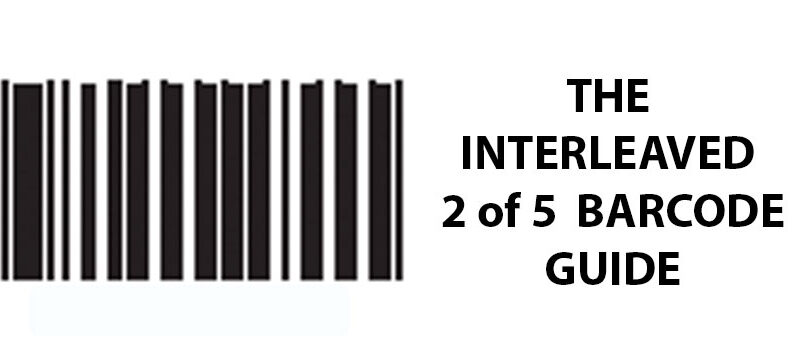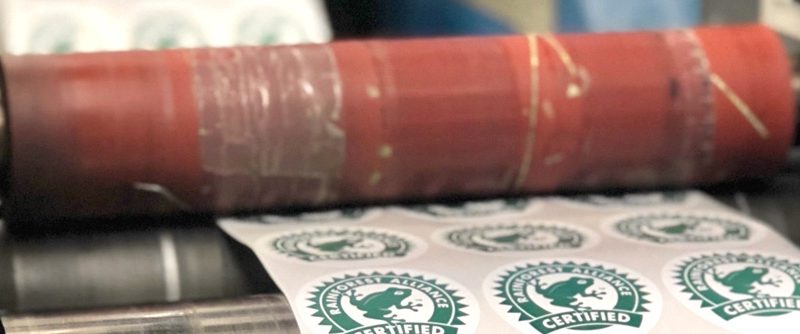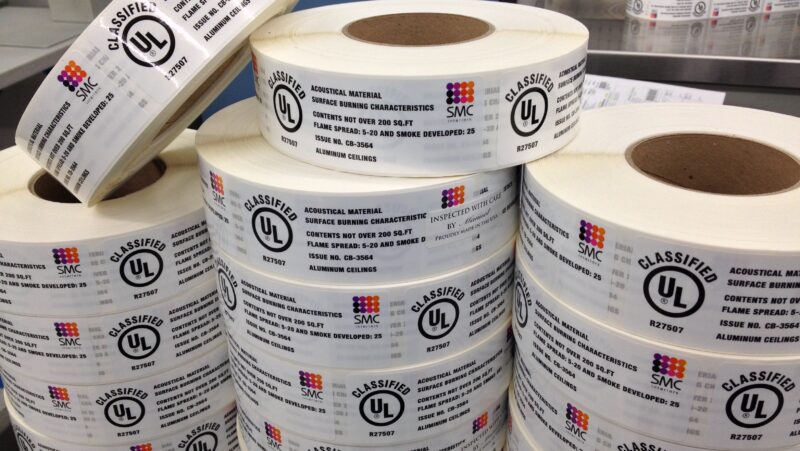The Interleaved 2 of 5 barcode, which has been in use since 1972, is a classic symbology that is still used today. Interleaved 2 of 5 barcodes are widely used, especially in industries that require barcodes that are both compact and reliable. Interleaved 2 of 5 barcodes have a distinct pattern of alternating narrow and wide bars and can encode more data than symbologies like Code 39.
Interleaved 2 of 5 barcodes are used everywhere from inventory management and logistics to industrial automation and package tracking. In this guide, we’ll explain everything you need to know about this rich symbology, including what an Interleaved 2 of 5 barcode is, what they’re used for, their structure, as well as their pros and cons.
What Is an Interleaved 2 of 5 Barcode?
An Interleaved 2 of 5 barcode, also called an ITF barcode, uses the Interleaved 2 of 5 symbology to encode number 0 to 9. It is called “interleaved” because the digits are encoded using alternating bars and spaces. Each character is represented by five bars, two wide (hence “2 of 5”) and three narrow.
Unlike other barcode types, like Code 39 or Code 128, an Interleaved 2 of 5 barcode encodes pairs of digits into single characters. This means that ITF barcodes must have an even number of digits. If your numeric data has an odd number of digits, a zero can be added to the beginning.
Interleaved 2 of 5 barcodes are commonly used in logistics, industrial applications, and transportation, where space is limited and only numeric data needs to be encoded.
What They’re Used for
Because ITF barcodes are both accurate and quick to scan, they are used in a number of different industries and applications. An Interleaved 2 of 5 barcode can encode a lot of data in a small space. Here are some common uses of Interleaved 2 of 5 barcodes:
- Warehousing: ITF barcodes are commonly used for inventory management, stock control, and tracking shipments within a warehouse. A simple scan of the barcode updates the contents of a box or pallet, to count or track inventory.
- Retail: While less common in retail settings compared to UPC or EAN, ITF barcodes are found on certain types of products where only numeric data is needed. While an Interleaved 2 of 5 barcode cannot be scanned with a Point-of-Sale scanner, they are used to track inventory levels and manage product pricing.
- Shipping: The transportation and logistics industry relies on Interleaved 2 of 5 barcodes to track packages as they move through the supply chain. With a quick scan, the package’s location can be updated in the logistics system. These barcodes also help with automated sorting as packages move from location to location.
- Healthcare: In healthcare settings, these barcodes are used to label medical equipment, track inventory of pharmaceuticals and medical supplies, as well as manage patient records.
- Manufacturing: The manufacturing industry uses ITF barcodes to track unfinished products, finished products, as well as materials and component parts. Scanning the barcode helps with inventory counts and quality control in the manufacturing process.
How to Recognize One
Because of its distinct appearance, an Interleaved 2 of 5 barcode is pretty recognizable. ITF barcodes consist of parallel bars of varying thickness separated by spaces. They only encode numeric data with an even number of digits and can encode up to 14 digits. If you find an odd number, it likely isn’t an Interleaved 2 of 5 barcode. Another distinct aspect of an ITF barcode is the use of two wide bars and three narrow bars per character.
If you’re unsure whether or not something is an Interleaved 2 of 5 barcode, one surefire way to find out is with a barcode testing app or other software that recognizes the ITF symbology.
The Structure of an Interleaved 2 of 5 Barcode
The ITF symbology uses a pattern of bars and spaces to represent the numbers 0 through 9. Here’s a breakdown of the structure of an Interleaved 2 of 5 barcode:
- Quiet zones: Interleaved 2 of 5 barcodes need quiet zones on both sides of the barcode. These are clear spaces that make sure the scanner can read the barcode accurately. Quiet zones prevent interference from surrounding elements.
- Start pattern: ITF barcodes usually start with a specific pattern of bars and spaces that signal the beginning of the barcode data.
- Data characters: After the start pattern, the barcode data is encoded using pairs of digits. Each pair is represented by a specific pattern of narrow and wide bars. The interleaving pattern of two wide bars and three narrow bars represents one character. An additional narrow space separates characters.
- Stop pattern: After the end of the data, an Interleaved 2 of 5 barcode ends with a specific pattern of bars and spaces. This pattern signals the end of the barcode data.
- Check digit: For data with an odd number of digits, a check digit of 0 is added to the beginning so the digits can be split into pairs. Data with an even number does not need a check digit.
How to Get One
Getting an Interleaved 2 of 5 barcode is simple and often free. To generate an ITF barcode, you can use a barcode generator website, barcode generator software, or a barcode generation library in a programming language like Python or Java.
Once you find the barcode generator you want to use, you simply input the numeric data that is associated with your product, component, or asset. The generator will create a barcode that you can then print.
The Code 128 and GS1-128 Guide
The Design Specifications
When designing an ITF barcode, you’ll need to consider the bar height, bar width, and bar width ratios. Not following these specifications can result in a barcode that does not scan or produces errors.
- Bar height: One important consideration is the height of the bars and spaces. If the barcode will be used in an automated scanning environment, it will need a bar height of at least 32 mm (1.25 inches). For other uses, the barcode height can be as small as 13 mm (.5 inches), but 32 mm is recommended.
- Bar width: The width of the smallest bar is usually called the X dimension. Because the symbology relies on the varying widths of bars, it’s important to follow the appropriate specifications. For automated scanning, the bar width must be between .495 mm to 1.02 mm (0.019 inches to 0.040 inches). For all other applications, the X dimension should be between 0.250 mm to .495 mm (0.0098 inches to 0.019 inches).
- Bar width ratio: The difference between the narrow bars and the wide bars is called the bar width ratio. This is another important consideration that affects the scannability of the Interleaved 2 of 5 barcode. The bar width ratio should be in a range of 2.25:1 to 3:1. Once the barcode is generated, you should not attempt to stretch or scale it. This can affect the bar width ratio and cause errors when scanned.
- Quiet zones: Quiet zones are clear areas on both sides of the barcode that are free from any other printing or graphics. They are essential for ensuring the barcode can be scanned accurately. You should leave at least 2.5 mm of space between the barcode and other elements of the label or packaging.
Bearer Bars
Bearer bars are an optional design specification for Interleaved 2 of 5 barcodes. They are thin lines that separate the barcode from the surrounding text or graphics. In some cases, they are only placed on the top and bottom, but they can also be used to completely frame the barcode. Bearer bars act as a reference point for the scanner and can help with scanning accuracy.
Bearer bars have two main uses:
- Some types of printing rely on flexible rubber plates to transfer the ink to the label. Bearer bars can be added to the rubber plates to keep it stiff so that the Interleaved 2 of 5 barcode isn’t distorted. This is especially helpful for printing on cardboard.
- Bearer bars set a clear boundary for the barcode. This helps when scanning, especially at steep angles. Bearer bars make scanning these barcodes easier and more accurate.
While bearer bars are not considered a mandatory specification, they are pretty helpful. In fact, GS1 recommends the use of bearer bars with ITF barcodes. When designing an Interleaved 2 of 5 barcode, the bearer bars must be at least 4.8 mm. Additionally, it’s important to remember that the bearer bars do not replace the quiet zones. The bearer bars go on the outside of the quiet zones so that the barcode can is still scannable.
Printing Rules
Once the Interleaved 2 of 5 barcode is designed, it’s time to print. In order to ensure the barcode can be scanned accurately, it’s important to following these printing rules:
- Color contrast: In order to be scannable, the Interleaved 2 of 5 barcode must have enough contrast. Most commonly, these barcodes use black or dark blue ink on a white background. There are other color combinations that can work, but black on white typically offers the highest contrast. Low-contrast color combinations, reflection materials, and the colors red, yellow, or orange will interfere with accurate scanning and should be avoided.
- Print quality: For an Interleaved 2 of 5 barcode, it’s essential to print in high-resolution. This ensures both the barcode and the human-readable text are clear and legible. Low-quality printing can cause smudged or disturbed barcodes, which can lead to scanning errors.
- Quiet zones: Maintain adequate quiet zones around the barcode to prevent interference from other elements on the product or label.
- Placement: The placement of the barcode is another important printing consideration. It should be at least 8 mm from the edge so that it doesn’t get obscured or distorted. You can check out this guide from GS1 for more detailed information.
- Orientation: Barcodes must be either completely horizontal or completely vertical. Any variation can cause issues with scanning. For curved surfaces, a vertical orientation is better than horizontal so that the ends of the barcode aren’t lost to the curve.
- Human-readable text: In addition to the encoded data, ITF barcodes usually include human-readable text above or below the barcode symbol. This is so that if the barcode is scratched or destroyed, the data can be entered manually. Keep in mind that the font should be clear and large enough to read. Most people use the fonts OCR-B or Helvetica.
- Test run: Before printing a large run of barcodes, it’s always a good idea to do a test run first. This helps you catch any errors in the barcode before printing the whole batch.
- Test the barcode: Another important step to printing an Interleaved 2 of 5 barcode is to test it under sunlight or bright light. This helps you double-check that the scanner can read the entire barcode. You’ll also want to look for scratches or smudges in the barcode that may prevent it from scanning.
Pros and Cons of the Interleaved 2 of 5 Barcode
Interleaved 2 of 5 barcodes have been in use for over 50 years. That’s because they offer data density in a compact space and are quick to scan. While ITF barcodes are slowly being replaced by newer symbologies, they come with a number of advantages as well as disadvantages. Here are some of the pros and cons of the Interleaved 2 of 5 barcode:
Pros:
- High density: ITF barcodes can encode a lot of numeric data in a compact space, which makes them ideal for situations where space is limited.
- Printing ease: Interleaved 2 of 5 barcodes are easy to print on a variety of surfaces using standard printing equipment. They do not require any specialized printing technologies, which makes them accessible for many different industries.
- Simple Structure: These barcodes have a simple structure of alternating bars and spaces representing numeric digits. This simplicity makes them easy to generate, decode, and integrate into many different systems and applications.
- Self-checking: ITF barcodes are self-checking, which means they don’t need a check digit.
Cons:
- Limited character set: While an Interleaved 2 of 5 barcode can encode a dense amount of numeric data, it can only encode numbers and not any alphanumeric characters or special symbols.
- Requires an even number: ITF barcodes require an even number of digits for encoding. This is easily resolved, however, by adding a zero to the beginning.
- Low data capacity: Because they only encode numbers, ITF barcodes have a lower data capacity than other barcode symbologies like Code 128 or QR codes.
ITF Barcode Labels
When you need Interleaved 2 of 5 barcode labels, Coast Label is here to serve. We offer high-quality printing to ensure the scannability of your labels. With our TruCheck verification system, we can ensure that all your barcode labels meet or exceed industry regulations for scannability. We use only the best materials to ensure that your ITF barcode labels endure the rigors of your industry.



